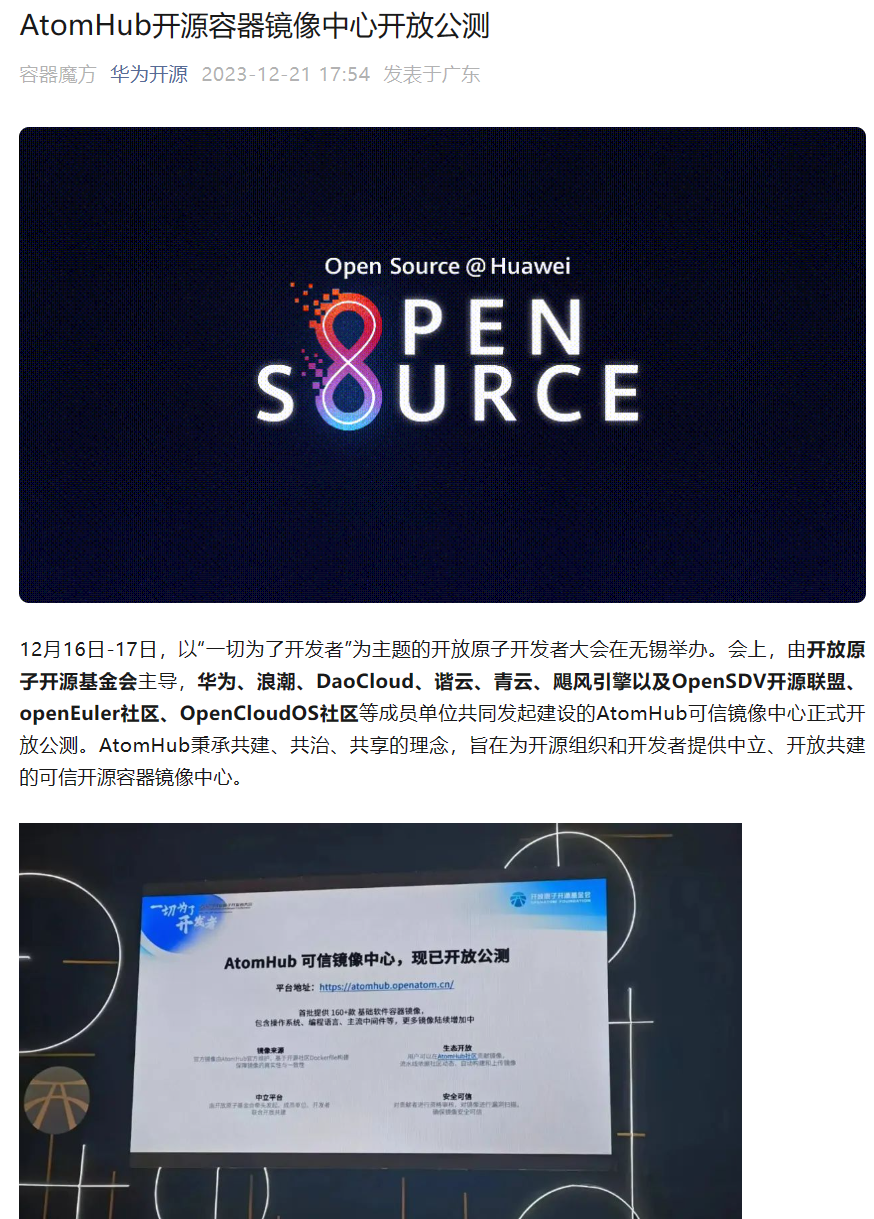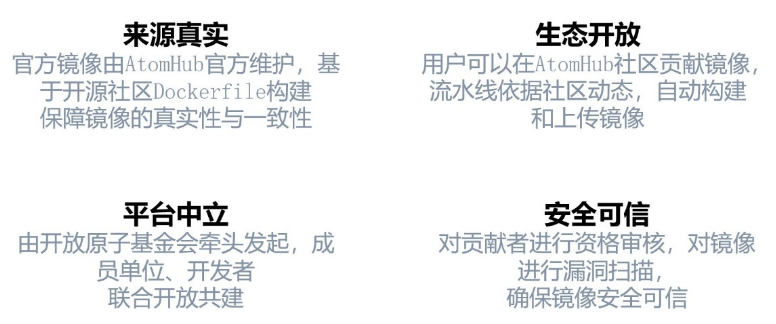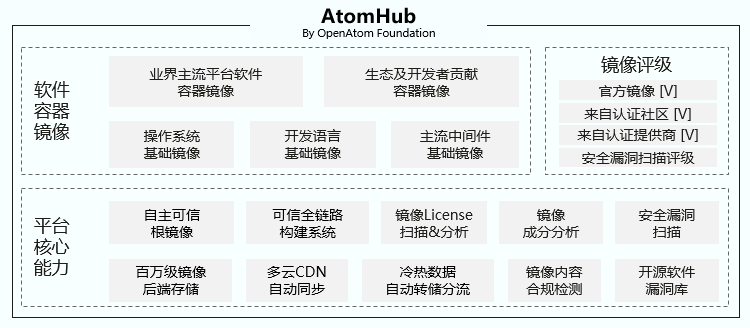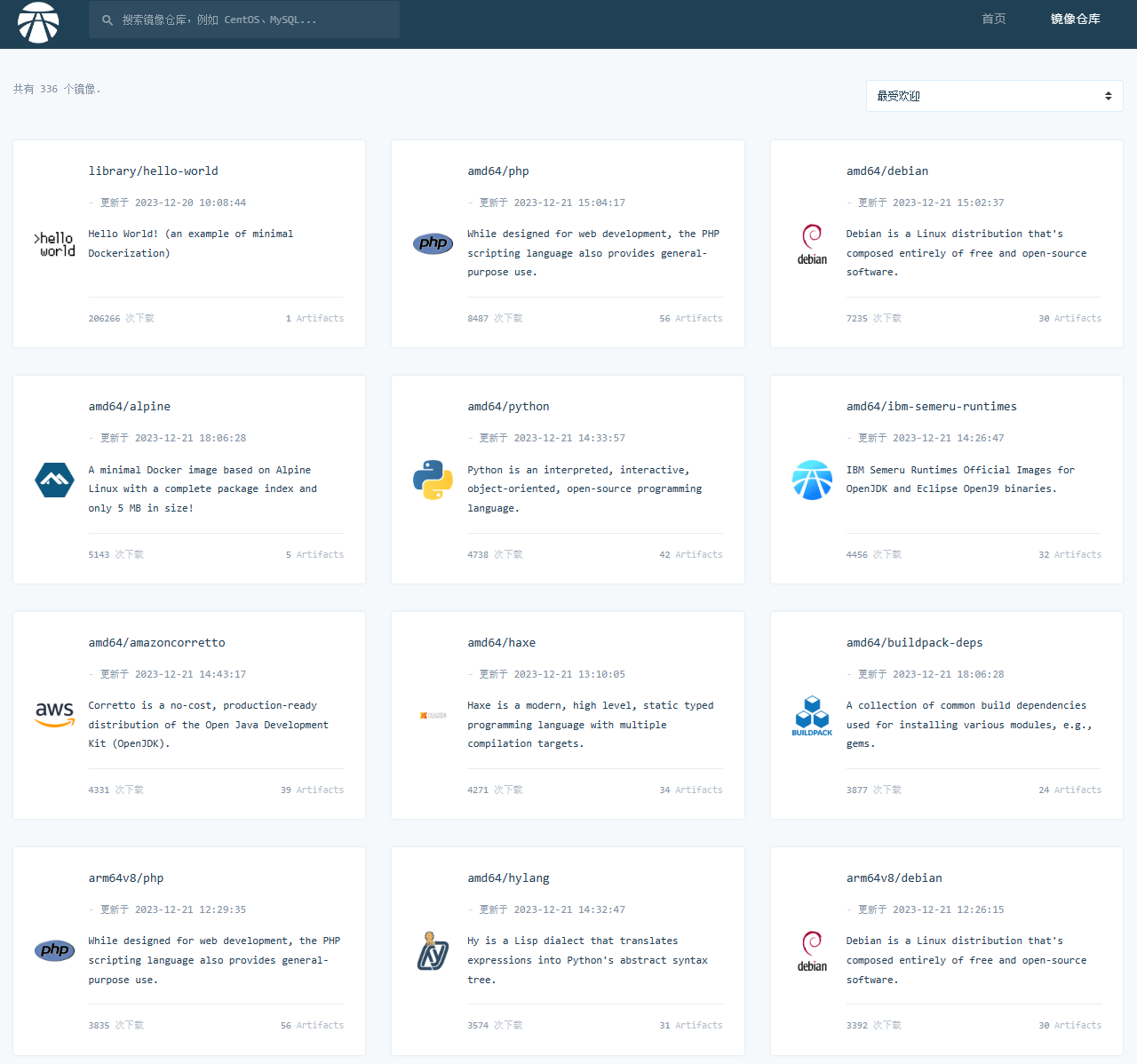 Technology peripherals
Technology peripherals
 It Industry
It Industry
 AtomHub, an open source container mirroring center jointly created by Huawei, Inspur and other units, announced that it is officially open for public testing and can stably download domestic services.
AtomHub, an open source container mirroring center jointly created by Huawei, Inspur and other units, announced that it is officially open for public testing and can stably download domestic services.
AtomHub, an open source container mirroring center jointly created by Huawei, Inspur and other units, announced that it is officially open for public testing and can stably download domestic services.
Huawei official news shows that the Open Atomic Developer Conference, with the theme of "Everything for Developers", was held in Wuxi for two days, from December 16th to 17th.
The conference was hosted by Open Atomic The AtomHub Trusted Mirror Center, led by the Atom Open Source Foundation and co-sponsored by Huawei, Inspur, DaoCloud, Xieyun, Qingyun, Hurricane Engine, and OpenSDV Open Source Alliance, openEuler community, OpenCloudOS community and other member units, is officially open for public beta . AtomHub adheres to the concepts of co-construction, co-governance, and sharing, and aims to provide open source organizations and developers with a neutral, open and co-constructed trusted open source container mirror center.

In view of the instability and uncontrollability of image warehouses such as Docker Hub, as well as the restrictions of some policies and regulations, developers are using these images Warehouses will also face various problems and difficulties
Network instability:Most container image hosting platforms, including Docker Hub, have servers located overseas and domestically. Users often encounter network delays and packet loss when accessing, resulting in frequent timeouts or request failures when uploading and pulling images.
Image pulling is limited: Taking Docker Hub as an example, anonymous users can only pull images 100 times within 6 hours, while free users who register and log in The image can only be pulled 200 times every 6 hours, which seriously affects the efficiency of image construction and application deployment.
Lack of neutral platform: Domestic users lack a neutral image sharing platform. Building images and uploading them to Docker Hub and then downloading them from China are restricted, which affects the use of container images in China. Share and spread.
In view of the above reasons, creating a neutral, open and co-constructed trusted open source container mirror center has become an urgent problem to be solved. The AtomHub project - the open source container image center was launched, aiming to provide developers with a new generation of open source container image center with authentic sources, open ecology, platform neutrality, security and trustworthiness


According to reports, AtomHub will adopt an image rating mechanism to ensure image quality and security.
The official image is an image officially released by AtomHub, with the highest reliability and security, covering a variety of popular operating systems, programming languages, databases, middleware and applications; certified community images are made by certified It is released by the open source community and complies with the quality standards and security specifications of the community; certified vendor images are released by certified software vendors and have high reliability and professionalism. At the same time, AtomHub also supports developers to build and publish images by themselves to meet personalized needs.

AtomHub will use domestic operating systems and software to build its own trusted root image and trusted full-link construction system, supporting security vulnerability scanning and Content compliance detection to promptly discover and repair image vulnerabilities and security risks, ensure that the image layer is safe and trustworthy, and re-establish a sustainable container image supply chain
AtomHub plans to use high-performance image storage backend, Key technologies such as multi-cloud CDN synchronization and automatic dumping and offloading of hot and cold data create a million-level concurrent scale container image distribution platform to provide users with stable and reliable image download services.
The five major strategic plans of this site are with AtomHub
Security:AtomHub will provide a complete set of security mechanisms, including image signatures , vulnerability scanning and content compliance detection and other functions to ensure that the image is safe and reliable.
High performance: AtomHub will use a high-performance storage engine and multi-cloud CDN acceleration to provide you with a high-speed image pull and push experience.
Ease of use: AtomHub will provide a user-friendly Web interface that supports keyword search, category browsing and image intelligent recommendation, making it easier for users to quickly find and download Required image.
Compatibility: AtomHub adopts the OCI standard and is compatible with the Docker Hub ecosystem. It can seamlessly connect with your existing container orchestration and continuous integration/continuous deployment (CI/ CD) tool.
Openness: AtomHub will be completely open source, creating an open, neutral and transparent container image sharing platform, allowing all enthusiasts to participate in the development, maintenance and use of the project.
As of the publication of this website, AtomHub open source container mirror center has a total of 336 mirrors.

AtomHub Trusted Mirror Center Platform Address:
Please visit the following link: https://atomhub.openatom .cn/
The above is the detailed content of AtomHub, an open source container mirroring center jointly created by Huawei, Inspur and other units, announced that it is officially open for public testing and can stably download domestic services.. For more information, please follow other related articles on the PHP Chinese website!

Hot AI Tools

Undresser.AI Undress
AI-powered app for creating realistic nude photos

AI Clothes Remover
Online AI tool for removing clothes from photos.

Undress AI Tool
Undress images for free

Clothoff.io
AI clothes remover

AI Hentai Generator
Generate AI Hentai for free.

Hot Article

Hot Tools

Notepad++7.3.1
Easy-to-use and free code editor

SublimeText3 Chinese version
Chinese version, very easy to use

Zend Studio 13.0.1
Powerful PHP integrated development environment

Dreamweaver CS6
Visual web development tools

SublimeText3 Mac version
God-level code editing software (SublimeText3)

Hot Topics
 1359
1359
 52
52
 ao3 mirror official website entrance
Feb 24, 2024 am 11:34 AM
ao3 mirror official website entrance
Feb 24, 2024 am 11:34 AM
ao3 mirror is a platform for creating fan fiction, but most friends don’t know where the official website of ao3 mirror is. Click on the https://ao3.cubeart.club/ link to enter the ao3 mirror website. The next step is The editor brings users an introduction to the latest official website entrance of ao3 mirror 2024. Interested users come and take a look! ao3 mirror official website entrance: https://ao3.cubeart.club/ 1. Download address 1. AO3: Click to download》》 2. AO3 latest version: Click to download》》 2. Enter the website method 1. Copy the website to View it in the browser and click [LogIn] in the upper right corner of the page to enter; 2. Account
 How to turn off AirPlay on Mac
Apr 16, 2023 am 09:49 AM
How to turn off AirPlay on Mac
Apr 16, 2023 am 09:49 AM
Turn off AirPlay on Mac via Control Center You can quickly turn off AirPlay in Mac OS Ventura 13 or later by doing the following: On a Mac with AirPlay enabled, go to Control Center in the upper right corner by clicking the two switch appearance icon and select " "Screen Mirroring" From the menu that appears, select the screen your Mac is AirPlay mirroring to. This will disconnect AirPlay and turn it off. You can also turn on ScreenMirroring and AirPlay this way, which you probably already know by now if you enabled it in the first place. . Disconnect AirPla on Mac via system settings
 Easily mirror your Acer laptop screen to TV with these steps
Apr 13, 2023 pm 07:10 PM
Easily mirror your Acer laptop screen to TV with these steps
Apr 13, 2023 pm 07:10 PM
Screen mirroring is the best option when you want to view or display content from a small screen to a large screen (for example, from a laptop to a TV). While you may have heard of the option to mirror your smartphone screen to your TV or laptop, you can also mirror your laptop screen to your TV. This will allow you to view the content on a larger screen. The process of mirroring your laptop screen to your TV can be done in a variety of ways, including wired and wireless. It's up to you which option you want to continue using. On the one hand, the wired approach gives you a reliable mirroring experience with low latency. However, the wireless method eliminates the need to find a compatible cable for mirroring and can be done between two supported devices. The only downside is that you'll experience some lag and sometimes low-resolution mirroring
 CentOS7 various version image download addresses and version descriptions (including Everything version)
Feb 29, 2024 am 09:20 AM
CentOS7 various version image download addresses and version descriptions (including Everything version)
Feb 29, 2024 am 09:20 AM
When loading CentOS-7.0-1406, there are many optional versions. For ordinary users, they don’t know which one to choose. Here is a brief introduction: (1) CentOS-xxxx-LiveCD.ios and CentOS-xxxx- What is the difference between bin-DVD.iso? The former only has 700M, and the latter has 3.8G. The difference is not only in size, but the more essential difference is that CentOS-xxxx-LiveCD.ios can only be loaded into the memory and run, and cannot be installed. Only CentOS-xxx-bin-DVD1.iso can be installed on the hard disk. (2) CentOS-xxx-bin-DVD1.iso, Ce
 How to use Docker for container failure recovery and automatic restart
Nov 07, 2023 pm 04:28 PM
How to use Docker for container failure recovery and automatic restart
Nov 07, 2023 pm 04:28 PM
As a lightweight virtualization platform based on container technology, Docker has been widely used in various scenarios. In a production environment, high availability and automatic failure recovery of containers are crucial. This article will introduce how to use Docker for container failure recovery and automatic restart, including specific code examples. 1. Configuration of automatic container restart In Docker, the automatic restart function of the container can be enabled by using the --restart option when running the container. Common options are: no: do not automatically restart. silent
 AtomHub, an open source container mirroring center jointly created by Huawei, Inspur and other units, announced that it is officially open for public testing and can stably download domestic services.
Jan 02, 2024 pm 03:54 PM
AtomHub, an open source container mirroring center jointly created by Huawei, Inspur and other units, announced that it is officially open for public testing and can stably download domestic services.
Jan 02, 2024 pm 03:54 PM
According to Huawei’s official news, the Open Atomic Developer Conference, with the theme of “Everything for Developers”, was held in Wuxi for two days, from December 16 to 17. The conference was led by the Open Atomic Open Source Foundation, Huawei, and Inspur. , DaoCloud, Xieyun, Qingyun, Hurricane Engine, as well as the OpenSDV Open Source Alliance, openEuler community, OpenCloudOS community and other member units jointly initiated the construction of the AtomHub Trusted Mirror Center, which is officially open for public testing. AtomHub adheres to the concepts of co-construction, co-governance, and sharing, and aims to provide open source organizations and developers with a neutral, open and co-constructed trusted open source container mirror center. In view of the instability and uncontrollability of image warehouses such as DockerHub, and some
 How to install Redhat Podman on Windows 10 or 11 via CMD
Oct 02, 2023 pm 09:33 PM
How to install Redhat Podman on Windows 10 or 11 via CMD
Oct 02, 2023 pm 09:33 PM
Install RedHatPodman on Windows 11 or 10 Follow the steps below to install RedHatPodman on your Windows machine using Command Prompt or Powershell: Step 1: Check System Requirements First, you have to make sure that your Windows system is running with the latest updates so that it can meet the requirements to run Podman requirements. You should be using Windows 11 or Windows 10 version 1709 (Build 16299) or higher and you have to enable Windows Subsystem for Linux 2 (WSL2) and VM features, well if they are not activated yet then you can use The two-step command executes this
 Win10 system installation guide
Dec 24, 2023 am 09:04 AM
Win10 system installation guide
Dec 24, 2023 am 09:04 AM
Recently, some friends reported that they downloaded the win10 image file, but they don’t know how to install it. What should I do? In fact, we can make a U disk boot disk and use the U disk to install it. Today, the editor has brought detailed information Let’s take a look at the specific solution steps. win10 image installation tutorial 1. Make a U disk boot disk 2. Download the Win10 system image file and copy it to the U disk boot disk 3. After making the U disk boot disk, quickly press F12 (some models are F8 ) Select the U disk to boot, enter the PE system, select the second option and press Enter to enter as shown below: 4. After a few minutes, enter the PE system, click on the PE installation tool on the desktop, and then click the "Browse" button in the main window of the tool. As shown in the figure below: 5.



